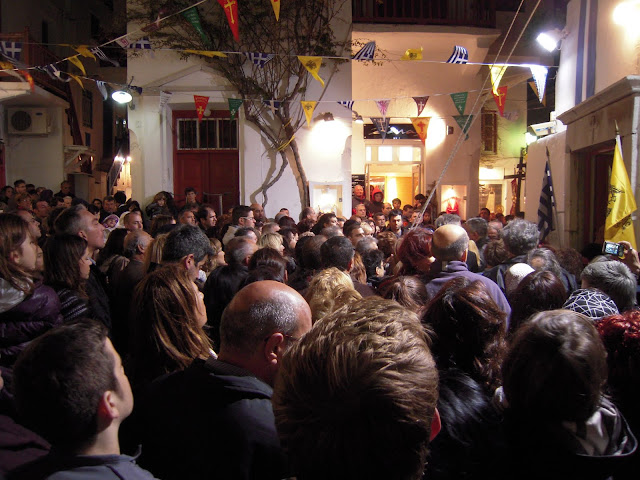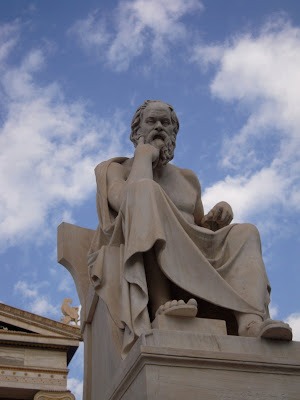Kalimera! Te Kanes? Kala.
When I left you, it was Easter Sunday and I was on the island of Mykonos. It has taken me from the Peloponnese to Thessaloniki and Athens to another island (Naxos) before I could find the time to blog again. I suppose I should start from where I left off. Believe it or not, we've moved around so much that the chronology is sketchy to me too.
Easter on Mykonos was beautiful.
We gathered outside of St. George's church in Mykonos for the midnight service. The flame from the church was passed around the courtyard before the priest came outside with the Scriptures and proclaimed "Christos Anesti" that Christ had risen. It was a triumphant moment. Witnessing this so far from home reminds me of how vibrant and transcendent faith can be when it is rooted in promise and hope.
After Mykonos, we returned to Athens for a 4 days. On the 27th, we visited the Sanctuaries of Eleusis and Epidavros in the Peloponnese.
Eleusis is an afterlife cult that was visited by Classical Greeks for the purpose of securing a more favorable share in death through the patronage of Demeter. The central temple was originally supposed to be completely dark to symbolize Hades. Promethean religion was fraught with confusion and fear of the unknown.
Epidavros was a healing sanctuary of the Cult of Asclepius. Hippocrates spent a significant amount of time here in the 5th c. BC. The most impressive part was the 30,000 capacity theatre they had there.
The next day, we had a tour of Roman era Athens which included the Roman Agora, Hadrian's Library, and the Temple of Olympian Zeus (pictured above). Prof. Fisher had received a phone call earlier in the day that gave us an exclusive invitation to tour the interior of the Parthenon. We trudged up the hill not knowing what would meet us. The only thing I can think to say is that is was spectacular.
The Galerius Rotunda, later turned into a Byzantine Orthodox Church
The Church of Hagios Demetrios (4th c.AD), the main church of Thessaloniki
When I left you, it was Easter Sunday and I was on the island of Mykonos. It has taken me from the Peloponnese to Thessaloniki and Athens to another island (Naxos) before I could find the time to blog again. I suppose I should start from where I left off. Believe it or not, we've moved around so much that the chronology is sketchy to me too.
Easter on Mykonos was beautiful.
We gathered outside of St. George's church in Mykonos for the midnight service. The flame from the church was passed around the courtyard before the priest came outside with the Scriptures and proclaimed "Christos Anesti" that Christ had risen. It was a triumphant moment. Witnessing this so far from home reminds me of how vibrant and transcendent faith can be when it is rooted in promise and hope.
After Mykonos, we returned to Athens for a 4 days. On the 27th, we visited the Sanctuaries of Eleusis and Epidavros in the Peloponnese.
Eleusis is an afterlife cult that was visited by Classical Greeks for the purpose of securing a more favorable share in death through the patronage of Demeter. The central temple was originally supposed to be completely dark to symbolize Hades. Promethean religion was fraught with confusion and fear of the unknown.
Epidavros was a healing sanctuary of the Cult of Asclepius. Hippocrates spent a significant amount of time here in the 5th c. BC. The most impressive part was the 30,000 capacity theatre they had there.
The next day, we had a tour of Roman era Athens which included the Roman Agora, Hadrian's Library, and the Temple of Olympian Zeus (pictured above). Prof. Fisher had received a phone call earlier in the day that gave us an exclusive invitation to tour the interior of the Parthenon. We trudged up the hill not knowing what would meet us. The only thing I can think to say is that is was spectacular.
This picture was taken on the top of a Byzantine bell-tower that remains next the west metope. We are very privileged students to say the least. Not only did we learn the extensive history of the Acropolis, but we got to witness the ground level of its extensive reconstruction.
Two days later we took a 7 hour train into Thessaloniki. The train was beautiful. After dozens of long bus rides, it was great to have a straight shot and a smooth ride. We passed Mt. Olympus in the early afternoon while I listened to a podcast lecture from Peter Kreeft. Thessaloniki was refreshing. It wasn't a tourist hub and the food was as good as it was cheap. To finish off the classical course, we visited the sites relating to the birth of Hellenism: Pella (the capital of Macedon), The School of Aristotle, and Vergina (the burial of Philip II). After a presentation, a paper, and a final exam, we passed into the Byzantine Era. Our new Professor, John Karavas, is brilliant and insightful. It's great because Byzantium is a subject that is outrageously overlooked in history courses. Immediately, we started visiting churches.
The Galerius Rotunda, later turned into a Byzantine Orthodox Church
The Church of Hagios Demetrios (4th c.AD), the main church of Thessaloniki
Acheiropoetus
Osios Loukas
On the road back from Thessaloniki, we stopped at Kalambaka for two nights to study the monastic sites of Meteora. We visited four monasteries there: Grand Meteora, Hagios Loukas, Varlaam, and Rousanou. They are all atop a beautiful rock range. The earliest monks lived in the crevasses of the mountains. The actual monasteries were built from the 7th-11th century.
After Meteora, we had stretch of Byzantine courses in Athens before ending up here in Naxos. Our last stop on the course is in Sparta. It's been great revisiting the principle history of the church in late antiquity from the Orthodox perspective. It's easy to see providence at work through the ages. This history is astounding. If I wasn't so worn out from traveling, I'd try to explain it all. Sorry. Here's a nice picture of the Paros "doorway" instead.
It was also great to spend my birthday in Athens with the kids in the group. It was hard being away from home, but the guys took me out for dinner and made me feel very loved.
I apologize for not keeping any of you well informed as to my whereabouts and goings on. This course is reasonably intensive by itself (we haven't had weekends and free days have been few and far between). Being constantly on the move and living out of a single suitcase eats away at any other luxury time. I really can't complain, though. I have yet to be without a roof or deprived of good food.
Speaking of which, I would recommend that all of you sample Souvlaki at some point. I personally prefer Kontosouvli, but fire roasted pork is less common than its aforementioned grilled skewer of a little-brother. Saganaki (fried feta cheese) is fantastic and you can easily get it in Chicago. Turkish coffee isn't half bad once you've become accustomed to it. The best cuisine I've encountered here has been the seafood. For a reasonable price on the islands, you can eat the freshest, most delicious seafood you could imaging. Octopus and mussels on Crete, catch of the day mullet and sardines in Pylos, and swordfish on Naxos were definite highlights. Stop in at my friend James's place, "Mama K's" on Grand across from Great America. He'll fix you up with a Gyro or Souvlaki if this has made you hungry. Dino over at Capt. Porkies on 41 and Wadsworth makes some pretty great Baklava, too.
Anyway, I am doing well and will be home in 7 days. At that point I will be uploading the remainder of my photos because my 5 year old laptop is currently refusing to cooperate with Facebook. I'll post a full trip summary when I return to the States. I will continue this blog through the summer whenever I do something I feel worthy of posting.
Until then,
Eddie





























































